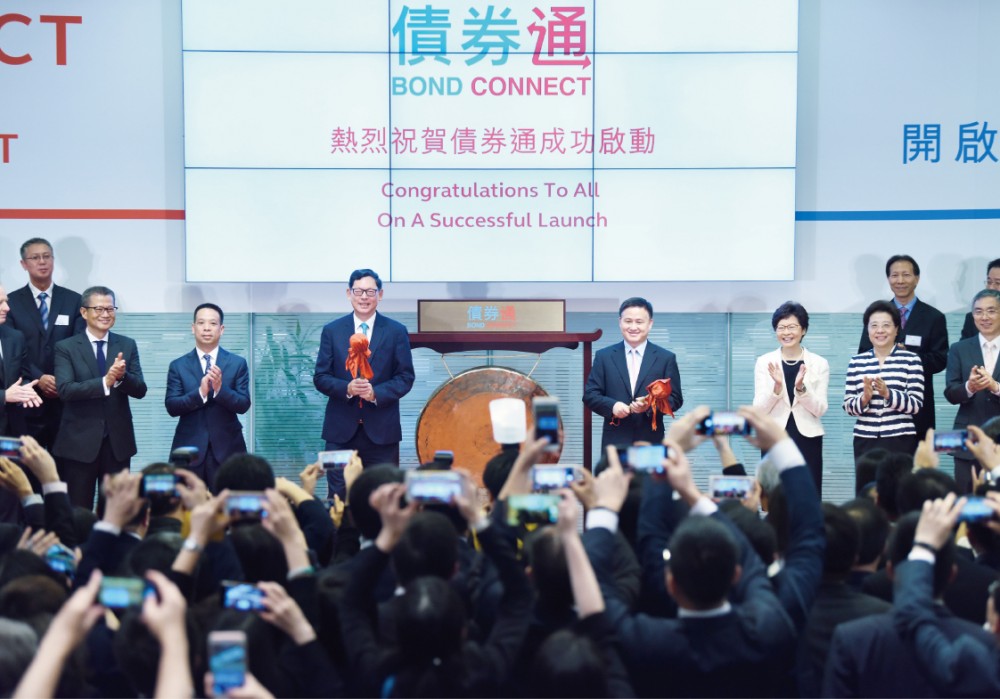Following the Shanghai-Hong Kong and Shenzhen-Hong Kong Stock Connect schemes, the long-awaited Bond Connect scheme has been launched recently. Is there any far-reaching significance in the Bond Connect’s launch during the 20th anniversary of Hong Kong’s reunification? What are the new opportunities for financial development in the Mainland and Hong Kong?
 In the process of RMB internationalization, safeguarding the rights and interests enjoyed by overseas RMB holders in freedom of payment, settlement and investment is a basic condition. Therefore, an open and beneficial RMB bond market is absolutely indispensable. Tse Yung-hoi, the Chamber’s Standing Committee Member and Chairman of BOCI-Prudential Asset Management Limited, pointed out that China Development Bank set off a wave of “dim sum bond” investments when it issued the first tranche of offshore RMB bonds in Hong Kong a decade ago. From 2007 to 2014, annual issue amount surged from just RMB10 billion to RMB250 billion, an increase of 25 times in eight years.
In the process of RMB internationalization, safeguarding the rights and interests enjoyed by overseas RMB holders in freedom of payment, settlement and investment is a basic condition. Therefore, an open and beneficial RMB bond market is absolutely indispensable. Tse Yung-hoi, the Chamber’s Standing Committee Member and Chairman of BOCI-Prudential Asset Management Limited, pointed out that China Development Bank set off a wave of “dim sum bond” investments when it issued the first tranche of offshore RMB bonds in Hong Kong a decade ago. From 2007 to 2014, annual issue amount surged from just RMB10 billion to RMB250 billion, an increase of 25 times in eight years.
Superiority in yield, liquidity and security
Tse said that the timely launch of the Bond Connect brings opportunities for foreign investors to directly invest in the Mainland bond market: first, with a scale of RMB66 trillion, the market has strong liquidity; second, China is sitting on USD3 trillion of foreign exchange reserves, so the market risk is low; third, relative to the main currency bonds, such as those of near zero interest rates in Europe and Japan as well as in the United States, the yields of Mainland bonds have always been higher, which are very attractive to the general investors who are most concerned about three major issues, namely, yield, liquidity and security level.
Tse believes that the Bond Connect marks a further step in interoperability between the capital markets of the Mainland and Hong Kong, and the timing of its launch during the 20th anniversary of Hong Kong’s reunification will also help affirm and strengthen Hong Kong’s role as a “super connector”.
Bond market as financing platform helps Mainland enterprises “go global”
The combination of the Bond Connect with the Shanghai-Hong Kong and Shenzhen-Hong Kong Stock Connect schemes enables market interoperability between the Mainland and Hong Kong, fully covering both stock and bond markets. Tse said that foreign institutional investors can trade in Mainland bonds via Hong Kong through the scheme; and the Mainland can conduct global asset allocation through Hong Kong to expand financing channels, while leading Mainland enterprises to “go global” and set foot in international markets. All these fully demonstrate Hong Kong’s unique strengths under the “one country, two systems” principle.
The Bond Connect covers both settlement and trading. Tse added that the Central Moneymarkets Unit (CMU), which is the bond market infrastructure operated by the Hong Kong Monetary Authority, will be used for settlement arrangements. Since this international settlement system is linked to Hong Kong’s system for payment in HKD, USD and euro, fund and bond settlements can be carried out concurrently in Hong Kong time, thus eliminating any settlement risks due to time difference.
Investment is straightforward and highly flexible
In addition to “dim sum bond”, foreign investors could invest in the Mainland bond market through QFII, RQFII and China’s interbank bond market (CIBM Direct) before the launch of the Bond Connect. However, Tse said that participants of QFII and RQFII are mostly independent institutional investors due to quota limits. And CIBM Direct has a reporting mechanism and its approval procedure is complicated. Other than having to open an account in the Mainland, foreign investors have to report its planned investment amounts to the relevant departments beforehand.
“In contrast, under the Bond Connect, investors can directly invest in the Mainland bond market through Hong Kong’s CMU system, which not only avoid the cumbersome procedures for account opening and approval, but also eliminate agent’s assistance for application and reporting, thus saving a lot of time and money.” Tse stressed that more importantly foreign investors, after selling their bonds, can transfer their funds to investment projects in other regions at any time, as there is no foreign exchange control in Hong Kong. There is a high degree of flexibility.
Both institutional and retail investors will benefit
 Tse added that in the early days of the Bond Connect’s launch, participating institutional investors were dominated by two categories: first, long-term investors sitting on a lot of money, such as central banks, pension funds and international institutions, who wanted to allocate some funds to stable government bonds and higher-rated corporate bonds in order to outperform inflation with long-term investment arrangements; second, fund companies or asset management companies in pursuit of profits to provide clients with wealth management products that offered higher returns on investment or were more diversified by buying and selling higher-yield products such as high-yield notes via the Bond Connect.
Tse added that in the early days of the Bond Connect’s launch, participating institutional investors were dominated by two categories: first, long-term investors sitting on a lot of money, such as central banks, pension funds and international institutions, who wanted to allocate some funds to stable government bonds and higher-rated corporate bonds in order to outperform inflation with long-term investment arrangements; second, fund companies or asset management companies in pursuit of profits to provide clients with wealth management products that offered higher returns on investment or were more diversified by buying and selling higher-yield products such as high-yield notes via the Bond Connect.
Some people pointed out that retail investors cannot benefit from the Northbound Bond Connect since it only allows institutional investors to participate. Tse believes that at present many of the institutional investors investing in the Mainland bond market through the Bond Connect are asset management companies, fund companies and insurance companies that offer ETF or insurance products; thus, retail investors may indirectly participate in the Bond Connect through the asset management products developed by such companies.
Huge size of bond market is attractive
“As mentioned earlier, the size of the Mainland bond market is as big as RMB66 trillion, second only to the United States and Japan, but the total amount of bonds held by foreign investors is only RMB800 billion, accounting for only about 1.2% of the Mainland bond market.” According to Tse, as of the end of last year, the total amount of outstanding bonds in the Mainland was about USD8.5 trillion, equivalent to 70% of GDP; in the same period, the US bond market was about USD35 trillion, or about 200% of GDP; in Japan, it was USD11 trillion, or about 250% of GDP. Based on the investment ratio and the bond market as a percentage of GDP, the Mainland bond market has huge potential for development.
Tse expects the Bond Connect to provide an important financing platform for the “Belt and Road initiative”. As to when the Southbound Bond Connect will be launched, it will depend on several key issues such as the further stabilisation of the RMB exchange rate and the ways to avoid the possible impact on Hong Kong’s smaller bond market due to the huge influx of funds from the Mainland.




